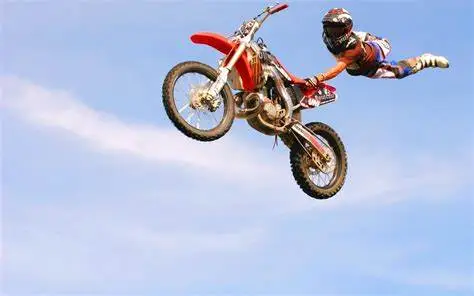What is Stunt Sport? History, Type, Athletes, Tips

Stunts can have different meanings depending on the context. In the world of the sport of cheerleading, “stunt” refers to a captivating four-quarter game between two teams, akin to football or basketball. Each quarter focuses on specific categories like partner stunts, pyramids and tosses, jumps and tumbling, and team routines. Teams have the freedom to choose from eight different routines in each quarter, ranging from the easiest (one) to the most challenging (eight). This competitive form of cheerleading showcases precision, skill, and creativity, with safety being a paramount concern.
In the world of sports and entertainment, “stunt” can also refer to a variety of different activities involving risky manoeuvres and circus skills, such as stunt driving or motorbike tricks.
Stunt sports are all about doing cool and daring things that make people go “Wow!” These sports have become super popular because they’re exciting and fun to watch.
1. History of Stunt Sports
Stunt sports have a long history that may be traced back to ancient entertainments such as acrobatics. With pioneers such as Buster Keaton, the advent of film in the twentieth century propelled cinematic stunts. Stunt driving in movies became popular throughout the motor era. Later, extreme sports such as skateboarding and BMX gained popularity. Stunt cheerleading became a competitive activity in the late twentieth century.
Stunt sports are now an important part of entertainment, with professional performers, specialized schools, and global recognition in events such as the X Games. The evolution demonstrates a synthesis of historical foundations, cinematic creativity, and the need for thrilling performances.
- Related Post: Top 20 Martial Arts Types and Their Categories
2. Types of Stunt Sports
Stunt sports are a diverse set of disciplines that feature exciting and risky feats. Among the notable varieties of stunt sports are:
- Stunt Driving: The practice of doing exact driving moves, jumps, and automobile chases as shown in movies and live events.
- Parkour and Freerunning: Focuses on efficient movement through urban environments, incorporating acrobatics, jumps, and fluid transitions.
- Aerial Stunts: Includes activities such as skydiving, BASE jumping, and aerobatic flying that showcase daring action in the air.
- Extreme Sports: Encompasses activities like skateboarding, BMX biking, and inline skating, where athletes perform tricks and stunts in high-risk environments.
- Stunt Water Sports: Involves daring maneuvers on water, such as cliff diving, jet ski stunts, and wakeboarding tricks.
- Fire Stunts: Features performers engaging in stunts involving fire, such as fire breathing, firewalking, and fire juggling.
- Combat Stunts: Seen in martial arts performances and action films, combat stunts involve choreographed fight sequences, often combining athleticism and martial arts skills.
- High Fall Stunts: Involves controlled falls from great heights, often performed by trained professionals using safety equipment.
- Horse Stunts: Includes equestrian stunts, such as trick riding and horse falls, commonly featured in historical films and live shows.
- Motorcycle Stunts: Encompasses tricks and maneuvers performed on motorcycles, such as wheelies, jumps, and stunts in motocross or freestyle motocross events.
These types of stunt sports require a combination of skill, training, and courage, and they continue to captivate audiences worldwide through various forms of entertainment.
3. Famous Stunt Athletes
Let’s talk about some folks who are really good at stunt sports and how they’ve inspired others to join in on the fun. Several famous stunt athletes have gained recognition for their exceptional skills and contributions to the world of stunt sports and entertainment. While it’s challenging to list all, here are a few notable names:
- Evel Knievel: A legendary motorcycle stunt performer known for his daredevil jumps and iconic motorcycle stunts in the 1960s and 1970s.
- Jackie Chan: Internationally acclaimed actor and martial artist known for performing his own stunts in numerous action films, showcasing a unique blend of acrobatics and martial arts.
- Tom Cruise: A Hollywood actor famous for performing his own stunts in action-packed movies, including the “Mission: Impossible” series, where he is known for his commitment to doing high-risk stunts.
- Travis Pastrana: An accomplished motorsports competitor and stunt performer, particularly in freestyle motocross and rally racing. He has also successfully recreated several of Evel Knievel’s jumps.
- Tony Hawk: A skateboarding legend and entrepreneur, Hawk is renowned for his pioneering contributions to the sport and his successful execution of groundbreaking tricks.
- Felix Baumgartner: An Austrian skydiver and BASE jumper who gained international fame for his Red Bull Stratos project, during which he performed a record-breaking freefall from the stratosphere.
- Angelina Jolie: An actress known for her roles in action films, Jolie has often performed her own stunts, including those in the “Tomb Raider” series and “Salt.”
- Rob Dyrdek: A professional skateboarder turned television personality and entrepreneur, Dyrdek has contributed significantly to the popularity of skateboarding and extreme sports through various media projects.
These athletes and performers have left an indelible mark on the world of stunt sports, showcasing exceptional skill, courage, and a passion for pushing the boundaries of what is possible in their respective fields.
4. Safety Measures in Stunt Sports
Doing stunts is cool, but safety is super important. Let’s look at how people stay safe while doing awesome stunts. The following are common safety measures implemented in stunt sports:
- Training and Certification: Stunt performers undergo rigorous training to develop the necessary skills and techniques for executing stunts safely. Many participate in specialized programs and obtain certifications to ensure competence.
- Professional Stunt Coordinators: Productions involving stunts often employ professional stunt coordinators. These individuals plan and oversee stunt sequences, ensuring that they are executed safely and effectively.
- Risk Assessment: Before performing a stunt, thorough risk assessments are conducted. This involves evaluating the potential dangers and implementing measures to mitigate risks.
- Protective Gear: Athletes and performers wear appropriate protective gear, such as helmets, padding, and body armor, depending on the nature of the stunt. This gear helps reduce the risk of injury.
- Rigging and Equipment Checks: Rigging for aerial stunts, harnesses, and other equipment undergo regular inspections to ensure they are in proper working condition. Any faulty equipment is replaced or repaired promptly.
- Rehearsals and Choreography: Stunt sequences are meticulously rehearsed to perfection. Performers work through each detail to minimize the likelihood of mistakes and ensure everyone involved knows their role in the stunt.
- Emergency Medical Personnel: On-site medical personnel, including paramedics, are often present during stunt performances. They are trained to respond quickly to any injuries or emergencies that may occur.
- Communication Systems: Clear communication is essential during stunt performances. Two-way radios or other communication systems allow performers, coordinators, and crew members to stay in constant contact and address any issues promptly.
- Weather Considerations: Outdoor stunts take weather conditions into account. Performances may be delayed or rescheduled if adverse weather poses a safety risk.
- Insurance Coverage: Productions involving stunts typically have comprehensive insurance coverage to address any injuries or damages that may occur.
- Stunt Doubles: In some cases, especially in film and television, trained stunt doubles may be used to perform certain stunts on behalf of actors, reducing the risk to the primary cast.
These safety measures collectively contribute to the overall well-being of stunt performers and athletes, allowing them to push the boundaries of their craft while minimizing the inherent risks associated with high-impact and acrobatic activities.
5. Stunt Sports as a Career
Believe it or not, some people turn their love for stunts into a job. If you have a question in mind about pursuing Stunt Sports as a career, the answer is absolutely yes! Many people have successfully turned their love for stunt sports into careers. It involves honing your skills, building a strong portfolio, networking in the industry, pursuing professional opportunities, and staying updated on trends. Safety is key, and diverse roles within the stunt industry offer various career paths. If you have the passion and skills, a career in stunt sports is an exciting possibility!
Conclusion
Stunt sports, ranging from cheerleading to motorcycle stunts and aerial performances, offer a dynamic and thrilling landscape. Renowned athletes like Evel Knievel and Jackie Chan have inspired the field. Safety is paramount, with measures such as rigorous training, professional coordination, and thorough risk assessments. For those considering a career, success requires honing skills, building a strong portfolio, and staying updated on industry trends. Stunt sports not only provide awe inspiring spectacles but also exciting career opportunities for passionate individuals with a love for daring feats.
FAQs
- Are stunt sports safe for people to do?
- Stunt sports are cool, and people work hard to make them safe for everyone.
- How can someone join in on stunt sports?
- You can start by joining local clubs or trying out beginner-friendly events.
- Do stunt athletes have special workouts?
- Yep, they follow special exercise routines to get strong and stay fit for their stunts.
- Can anyone join stunt competitions, or is there an age limit?
- Some events are open to everyone, while others might have age categories.
- How is technology changing stunt sports?
- Technology is making stunt sports even cooler with new equipment and better ways to show off stunts.




